Kealy Surname Ancestry ResultsOur indexes 1000-1999 include entries for the spelling 'kealy'. In the period you have requested, we have the following 71 records (displaying 61 to 70): Single Surname Subscription | | | Buying all 71 results of this search individually would cost £368.00. But you can have free access to all 71 records for a year, to view, to save and print, for £100. Save £268.00. More... |
These sample scans are from the original record. You will get scans of the full pages or articles where the surname you searched for has been found. Your web browser may prevent the sample windows from opening; in this case please change your browser settings to allow pop-up windows from this site. Boys entering Wellington College in Berkshire
(1931)
Wellington College, near Wokingham, was originally founded for the education of sons of military officers. A register of boys entering the school from First Term 1859 to Michaelmas 1933 was compiled by F. G. Lawrence for the Old Wellingtonian Society. In each entry the boy's name is given in full, in bold, surname first; age at entry (usually 11 to 14); then, in brackets, the name of the dormitory or house to which he belonged, in italics, with the years of his stay; then his father's name (usually surname and initials, but not christian name) with military decorations where appropriate. School prefects and captains are noted as such; if the boy played cricket for the school, XI with the years; academic honours, scholarships, &c.; most of the boys entering in this year were still at the school in 1933, and so for these the entries are very brief indeed.KEALY. Cost: £6.00.  | Sample scan, click to enlarge
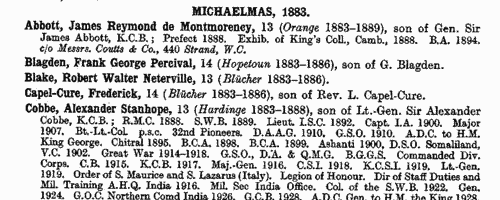
| Boys entering Marlborough College
(1933)
The public school at Marlborough in Wiltshire was founded in 1843. In 1952 this, 9th, edition of the college register was published, being a revision by L. Warwick James of the 8th edition (of 1936): but for the years before 1936 it does not merely repeat the 8th edition, because Warwick James was able to correct the 19th-century entries with information from newly-discovered letters and books from 1843 to 1853, and the school lists from 1844 onwards. The roll is arranged by year, and within each year by term of entrance, and then alphabetically by surname within each term. Each boy is assigned a number within the year: then his name is given, surname first, and, in brackets, his house. The houses within the college were called B1, B2, B3, C1, C2 and C3, and the Lower School (L Sch); the out college houses were Preshute, Priory, Cotton, Hermitage, Littlefield, Barton Hill, Summerfield and Upcot. Then there is given the boy's father's name (surname and initials) and address (at entrance), the boy's date of birth (b) and month of leaving (l). Where the boy represented the school at Rugby football (XV) or cricket (XI), in the rifle corps (VIII, or RC XI), that is indicated. There is a brief summary of achievements in later life, and, where known, and date of death or (in italics) address as in 1952. KEALY. Cost: £4.00.  | Sample scan, click to enlarge
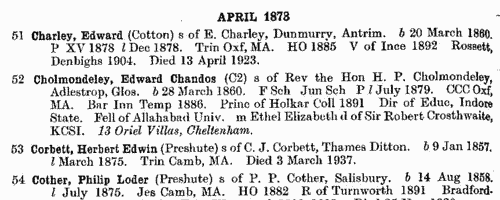
| Officers of the British Army and of the Indian Army
(1934)
The Half-Yearly Army List, issued By Authority, 30 June 1934, lists all officers in active service at that date, and this list was evidence of the status and rank of the officers contained in it. The entries are set out as a gradation list, by rank, from field-marshals to lieutenants, and within each rank in order of seniority at that rank. Each officer's name (surname first, in capitals, then christian name and present rank (with date of achieving that rank) and regiment &c. are given, for convenience, in bold type, with any national decorations in italics after the name. Each entry also gives date of birth, number of days service in the ranks, dates of service in each rank of officer, particular offices and postings (with dates) and, where appropriate, a summary of war service, and medals. For all but the oldest of the officers then serving, the war service details are for the Great War (1914-1921), and campaigns in Iraq, Waziristan, and the North West Frontier of India. War services are not given in this edition for Indian Army officers, except in that their entries are preceded by a crossed swords symbol where they have seen war service in a theatre of war overseas. After the gradation list of officers, there is a section for the Royal Malta Artillery; and then (pages 1152 to 1185) warrant officers - staff or garrison serjeant-majors, educational serjeant-majors, serjeant-major (physical training and educational) instructors, regimental serjeant-majors (and corporal-majors, farrier-serjeant majors, master gunners, assistant instructors in gunnery, experimental serjeant-majors, artillery clerks, farrier-serjeant-majors, artificer serjeant-majors, clerks of works, mechanist, superintending clerks, draughtsmen, 1st class staff serjeant-majors, transport, supply, conductors, sub-conductors, armourers, armament artificers, headmasters, schoolmasters, marine gunners, and bandmasters. The section for the Royal Army Chaplains' Department lists all chaplains (1st to 3rd class); and that for Queen Alexandra's Imperial Military Nursing Service has all matrons, sisters and staff nurses. The lists of nurses do not give date of birth: all are unmarried. The book concludes with the Yeomen of the Guard, the Honourable Company of Gentlemen-at-Arms, and the King's Body Guard for Scotland, in each case giving name (surname and initials, not christian names), honours, name of late regiment, and date of appointment.
KEALY. Cost: £4.00.  | Sample scan, click to enlarge

| University of Ireland Diploma in Dairy Science
(1937-1939)
The University of Ireland was established by royal charter in 1908, with three constituent colleges - University College, Dublin; University College, Cork; and University College, Galway. The university calendar for 1940 includes this list of those students awarded the Diploma in Dairy Science but who were not graduates in the university.KEALY. Cost: £6.00.  | Sample scan, click to enlarge

| Naval Officers
(1939)
The alphabetical list of officers on the Active List of the Royal Navy and Royal Marines (RM) gives: where serving; name (surname and initials); rank; and the dates of their seniority. This is the list from the March 1939 edition of the Navy List, corrected to 18 February 1939.KEALY. Cost: £4.00.  | Sample scan, click to enlarge

| University of Ireland Members of Convocation
(1940)
The University of Ireland was established by royal charter in 1908, with three constituent colleges - University College, Dublin; University College, Cork; and University College, Galway. The university calendar for 1940 includes this complete list of Members of Convocation. It is similar to the general list of graduates of the university, but not exactly the same, for it includes academic staff of the university not necessarily graduates of the same, and not all graduates registered for membership of convocation. The list gives full names (surname first), degree and year of graduation, and, importantly, full address as in 1940 - information not given in the general list. Where the current full address was not known, the last known address was given, the entry being in italics.KEALY. Cost: £4.00.  | Sample scan, click to enlarge
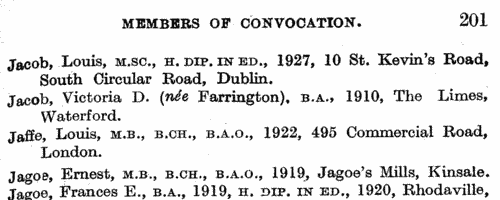
| Royal Corps of Signals: Regular Army Emergency Commissions: 2nd Lieutenants
(1946)
The Army List for October 1946 lists the 4300 officers of the Royal Corps of Signals by rank and seniority (i.e., the date from which their particular rank was to be reckoned). The names are given as surnames and initials. The many temporary commissions bestowing brevet or higher rank are listed in italics, with date, together with any decorations. In front of the surnames three abbreviations may occur: a bold R, meaning released to unemployment; a crossed-swords symbol for meritorious war service; and a pilcrow, for service without pay and allowances. There are separate sections for retired officers temporarily re-employed, the Territorial Army, and Regular Army Emergency Commissions (including African Colonial, Caribbean, Egypt and Palestine forces), Supplementary Reserve Category B.
KEALY. Cost: £4.00.  | Sample scan, click to enlarge
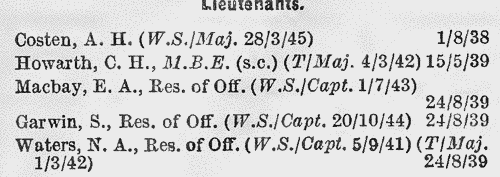
| Royal Corps of Signals: Regular Army Emergency Commissions: Majors
(1946)
The Army List for October 1946 lists the 4300 officers of the Royal Corps of Signals by rank and seniority (i.e., the date from which their particular rank was to be reckoned). The names are given as surnames and initials. The many temporary commissions bestowing brevet or higher rank are listed in italics, with date, together with any decorations. In front of the surnames three abbreviations may occur: a bold R, meaning released to unemployment; a crossed-swords symbol for meritorious war service; and a pilcrow, for service without pay and allowances. There are separate sections for retired officers temporarily re-employed, the Territorial Army, and Regular Army Emergency Commissions (including African Colonial, Caribbean, Egypt and Palestine forces), Supplementary Reserve Category B.
KEALY. Cost: £4.00.  | Sample scan, click to enlarge
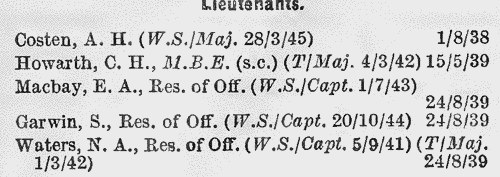
| Associate Members of the Institution of Mechanical Engineers (A. M. I. Mech. E.)
(1947)
The Institution of Mechanical Engineers, founded in 1847, was incorporated by royal charter in 1930. The list of members of 1 March 1947 gives the names (surname first) and addresses of the seven classes of member - Honorary Members (Hon. M. I. Mech. E.); Members (M. I. Mech. E.); Associate Members (A. M. I. Mech. E.); Companions (C. I. Mech. E.); Associates (A. I. Mech. E.); Graduates (G. I. Mech. E.); and Students (S. I. Mech. E.). The year of attaining qualification is given in the left-hand margin; in the higher grades the years of achieving the lower grades are also given, bracketed together. The crossed swords symbol indicates naval or military service during the Great War of 1914-1918; an italic b shows a member of the Benevolent Fund. (p) after a Graduate's or a Student's name indicates one who had passed the whole of the A. M. Examination or its recognized equivalent.KEALY. Cost: £4.00.  | Sample scan, click to enlarge
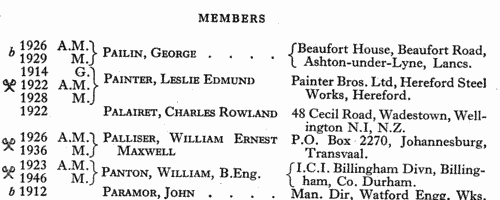
| Doctors trained in Britain or Ireland but living abroad
(1948)
The Medical Directory was split into several sections. The Practitioners Resident Abroad section covered all medical practitioners who, having qualified in Britain or Ireland, were living abroad. Each year a schedule was sent to each doctor to be returned to the publishers, so as to keep the directory up to date. In the directory the doctor's name is given first, in bold, surname first, in capitals; then current address. Next are the qualifications; the italic abbreviations in parentheses following the qualifications indicate the medical school at which they were gained. Then there is a list of posts and honours within the profession, starting with those then current; previous posts are preceded by the word 'late'. Finally, brief details are given of any publications. Inclusion of names in the list did not imply a right to practise in the country of residence.KEALY. Cost: £2.00.  | Sample scan, click to enlarge
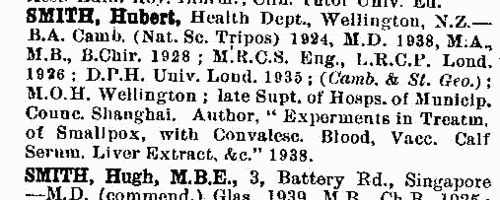
|
Research your ancestry, family history, genealogy and one-name study by direct access to original records and archives indexed by surname.
|












